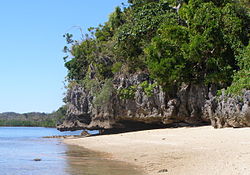
Intertidal ecology is the study of intertidal ecosystems, where organisms live between the low and high tide lines. At low tide, the intertidal is exposed whereas at high tide, the intertidal is underwater. Intertidal ecologists therefore study the interactions between intertidal organisms and their environment, as well as between different species of intertidal organisms within a particular intertidal community. The most important environmental and species interactions may vary based on the type of intertidal community being studied, the broadest of classifications being based on substrates—rocky shore and soft bottom communities.[1][2]
Organisms living in this zone have a highly variable and often hostile environment, and have evolved various adaptations to cope with and even exploit these conditions. One easily visible feature of intertidal communities is vertical zonation, where the community is divided into distinct vertical bands of specific species going up the shore. Species ability to cope with abiotic factors associated with emersion stress, such as desiccation determines their upper limits, while biotic interactions e.g.competition with other species sets their lower limits.[1]
Intertidal regions are utilized by humans for food and recreation, but anthropogenic actions also have major impacts, with overexploitation, invasive species and climate change being among the problems faced by intertidal communities. In some places Marine Protected Areas have been established to protect these areas and aid in scientific research.[3]
- ^ a b Raffaelli, David; Hawkins, Stephen J. (1996). Intertidal Ecology. Springer. ISBN 978-0-412-29950-6.
- ^ Tomanek, Lars; Helmuth, Brian (2002). "Physiological Ecology of Rocky Intertidal Organisms: A Synergy of Concepts" (PDF). Integrative and Comparative Biology. 42 (4) (published August 2002): 771–775. doi:10.1093/icb/42.4.771. PMID 21708774.
- ^ National Academy of Sciences. Marine protected areas: tools for sustaining ocean ecosystems/ Committee on the evaluation, design, and monitoring of marine reserves and protected areas in the United States Ocean Studies Board Commission on Geosciences, Environment, and Resources National Research Council. National Academy Press, Washington, D.C., 2001
© MMXXIII Rich X Search. We shall prevail. All rights reserved. Rich X Search
